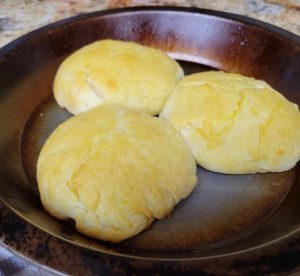
Here are some of the most popular questions related to Easy Self-Rising Flour Biscuits along with their answers:
- What is self-rising flour, and can I use it instead of all-purpose flour?
- Self-rising flour is a combination of all-purpose flour, baking powder, and salt. It’s commonly used in biscuit recipes because the leavening agents are already incorporated. You can use self-rising flour in place of all-purpose flour in biscuit recipes, but you’ll need to adjust the amount of baking powder and salt accordingly.
- Can I substitute heavy cream with milk or buttermilk?
- While heavy cream contributes to the rich and tender texture of the biscuits, you can substitute it with whole milk or buttermilk if needed. Keep in mind that the texture and flavor may vary slightly depending on the substitution used.
- Can I freeze unbaked biscuit dough for later use?
- Yes, you can freeze unbaked biscuit dough for later use. Shape the dough into biscuits, place them on a baking sheet lined with parchment paper, and freeze until solid. Once frozen, transfer the biscuits to a freezer bag or container. When ready to bake, simply place the frozen biscuits on a baking sheet and bake according to the recipe instructions, adding a few extra minutes to the baking time.
- How do I store leftover baked biscuits?
- Allow the baked biscuits to cool completely, then store them in an airtight container at room temperature for up to 2 days. To reheat, wrap the biscuits in aluminum foil and warm them in a 350°F (175°C) oven for 10-15 minutes, or until heated through.
- Why did my biscuits turn out tough?
- Tough biscuits are often the result of overworking the dough. Be sure to handle the dough gently and avoid kneading it too much. Additionally, using cold ingredients and a hot oven helps create steam pockets, resulting in tender biscuits.
- Can I make sweet biscuits using this recipe?
- Yes, you can make sweet biscuits by adding sugar to the dough or incorporating sweet ingredients like dried fruit or chocolate chips. Adjust the amount of sugar to taste, and consider adding a sprinkle of sugar on top of the biscuits before baking for added sweetness and crunch.
- How do I achieve a golden-brown crust on my biscuits?
- To achieve a golden-brown crust, brush the tops of the biscuits with melted butter before baking. You can also bake the biscuits on a preheated baking sheet for even browning.
- Can I make gluten-free biscuits using self-rising flour?
- While self-rising flour contains wheat flour, you can make gluten-free biscuits using a gluten-free self-rising flour blend. Look for commercially available gluten-free self-rising flour blends or make your own by combining gluten-free flour with baking powder and salt.
- What’s the best way to serve biscuits?
- Biscuits are delicious served warm with butter, jam, honey, or gravy. They make a great side dish for breakfast, brunch, or dinner, and can also be enjoyed on their own as a tasty snack.
- How do I prevent my biscuits from spreading too much during baking?
- To prevent biscuits from spreading too much, be sure to handle the dough gently and avoid overworking it. Additionally, make sure your oven is fully preheated before baking, and bake the biscuits on a hot baking sheet to help them rise quickly and hold their shape.
These are some of the common questions and answers related to Easy Self-Rising Flour Biscuits that may arise when making or serving this classic baked treat.
